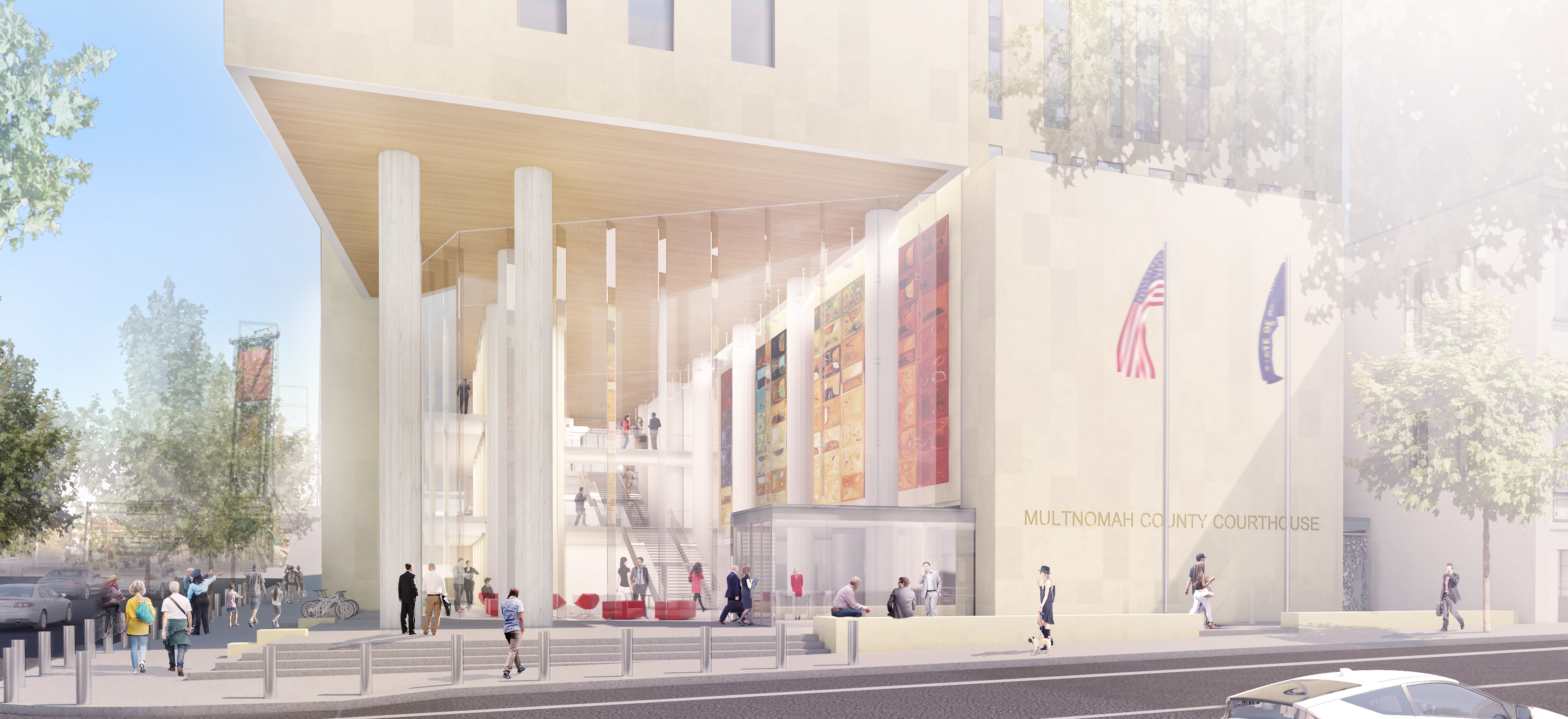Photo credit: SRG Partnership, Inc. ©2016
Open scene: It’s a rainy Monday morning, and a long line of bleary-eyed people are slowly making their way into the courthouse. People with court dates, attorneys, court staff, and others are peeling off belts, shoes, loose change, and whatever else is triggering the metal detector alarm. The incessant beeping heightens the alarm of people trying to make their way into the courthouse, many of whom are waiting in the rain just outside the door. Security staff are barking orders; frustration is rising. Upon making it through the ordeal, people grab their belts, shoes, and bags off the moving belt; and in the midst of the bustle of the main court lobby area, they try to pull themselves back together again. Eyebrows burrow in the face of the next challenge: finding the correct courtroom as lines have started to form everywhere. Faces show the stress of awaiting decisions, many of which will be life-altering. Some people are facing decisions regarding the custody of their children; others may learn of a major financial loss or gain; still others are going to learn the fate of a criminal charge. Some people don’t quite make it into the main lobby. The stress of the process leads to tensions flaring; suddenly, voices are raised and a person is being escorted off the premises. This person will not show up for their court date, after all.
The challenges of navigating the court system are numerous. Often people have little familiarity with or understanding of the many requirements, dates, and costs associated with the court process. In many jurisdictions, the complexity of justice-involvement couldn’t be more clearly epitomized than within the courthouse itself. The tall, formidable buildings are often structured for business as it was conducted decades ago, with long halls and confusing courtroom numerations. Most buildings were not built for the post-9/11 world, where security screenings block small entrances and afford no privacy to people stripping down their belts, shoes, and jackets.
Judicial leader Judge Nan Waller, in Multnomah County, Oregon, has a story about observing the way that people struggled to enter their courthouse. As she stood watching one morning, she saw that if it was raining, people had to wait in line in the rain. If people didn’t know their way around the courthouse, they were often worrying about where to find directions as they waited to clear security. She realized that the very entrance to the building was increasing the anxiety of people simply trying to tend to their business. She also observed tensions flaring between people coming to court and security staff. Most concerning, she has seen people escorted off the premises after such an encounter and forced to miss their court hearing, leading to another chain of events resulting from the failure to appear and the need to reschedule the hearing.
Within courthouses across the nation, people with a history of or current trauma from victimization, abuse, racism, natural disasters, or other factors are seeking services or are required to attend hearings . Hence, the need for incorporating trauma-informed approaches and systems of care has become imperative. In Portland, Oregon, trauma-informed principles are going beyond practice and are being institutionalized into their very building structures.
The new Multnomah County Central Courthouse will be the result of a true collaboration between county, court, legislative, and community members, which led to a wide range of input into the design and features of the new building. The $300 million, 17-story building will incorporate critical trauma-informed designs to enhance the wellness of people working and conducting business in the courthouse.
The Multnomah Circuit Court leadership began with a vision that “The new Multnomah County Central Courthouse will enhance confidence in the justice system, inspire civic engagement and urban vitality, and provide a restorative human experience within a resilient and responsible community landmark.” The leadership embraced the reality that if people were supported with information, safe spaces, and easier processes, then there would likely be a reduction in stress levels, conflicts in the hallway, and people being asked to leave the courthouse. Ultimately, people might become more receptive to advice, decisions, and orders coming from counsel and the bench, thus making the work of the judiciary more effective.
In order to reach their vision, court leadership set a mission “to design and build a sustainable, accessible landmark courthouse that is a symbol of the importance of the justice system and a source of civic pride. The new courthouse will incorporate 21st century building practices in operations, security, and design, capable of adapting to changing needs over a 100-year life span.”
They held focus groups with community members, particularly with groups of people that have historically been excluded from conversations, such as victims and victims’ representatives, people with disabilities, elder advocates, and various minority racial and ethnic groups. As a result, some key features of the new courthouse include the following:
Re-engineered Entry Process
The new entrance will have sufficient space for the lines that will form; these lines will fall by glass walls behind which the outdoor green space will be within view. Information will be provided to people in line regarding the locations of courtrooms or offices they will need to find once through the security line. The entry will be accommodating to people with disabilities.
Way-Finding
A modern way-finding system will help people locate the courtroom or offices they need to access. The public hallways will all face a beautiful view, in order to enhance the environment and reduce stress levels. Where possible, glass is incorporated into the design, imparting a sense of transparency and accessibility throughout the building.
Kiosks
Electronic kiosks will allow people to sign in to be called for services rather than standing in line; the kiosks will also provide options for completing paperwork and other tasks while they wait to be served. At the least, the kiosks will help people confirm that they are indeed waiting in the correct line for the services they need.
Private, Safe Space
Two small conference rooms are situated outside each courtroom in which people will be able to fill out paperwork, hold private conversations with legal counsel, or simply escape the busyness of the courthouse halls, allowing victims or defendants to seek some privacy. Four wellness rooms will be provided for lactation space or privacy for someone with an illness. Finally, a prayer room will be provided for people who wish to participate in their religious activities.
Legal Resource Center
The Legal Resource Center emerged as a priority as it became clear that many self-represented litigants are navigating through the legal process. Navigators and Facilitators will staff the room and provide support and direction in accessing resources, completing forms, and other services. Video orientations about different types of proceedings will be provided to people who are self-representing.
Staff Support
Staff will now have their own private breakroom, conference room, and bike locker room in order to encourage breaks, increase physical activity, and inspire interaction among staff. These features are intended to help counter the vicarious trauma that many staff experience through their daily work. Court leadership recognized that in order for their staff to provide the best services, staff must be able to recharge and take care of their own needs as well.
The new courthouse is yet another by-product of the Multnomah County Circuit Court’s Procedure Justice Initiative, through which the judges and staff of the court strive to adhere to their “Pledge of Fairness,” which includes commitments to ensuring people are heard, have their questions answered, and are treated respectfully. Completion of the new building is made possible through funding from both state and local sources, as a result of years of work by judicial leaders to educate each other, legislators, and other influential leaders around the need for a trauma-informed courthouse. This collaborative approach has proven key to increasing the area’s capacity to be truly trauma-informed, a critical take-away for other areas seeking to ensure their residents do not incur further traumatization due to justice involvement.
Many thanks to the Honorable Nan Waller and Trial Court Administrator Barbara Marcille at the Multnomah County Circuit Court for their leadership and sharing information regarding this tremendous facility forthcoming to the Multnomah County region.


